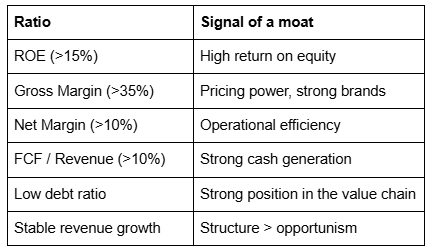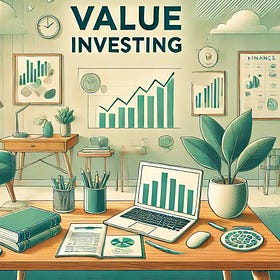Lesson 10: Moats – The Foundation of Sustainable Competitive Advantage
Value investing 101
“A fantastic business has a wide, deep moat… filled with crocodiles.”
— Warren Buffett
One of the most powerful ideas in the world of value investing is that of the moat — literally: a moat around a castle. It’s a metaphor Buffett uses to describe companies with durable competitive advantages. Companies you can rely on for years. Companies that generate more value than their competitors — and continue to do so.
In this lesson, we take a deep dive into the concept of moats:
What exactly are they?
Why are they crucial for long-term returns?
What types of moats exist?
How can you recognize them — both qualitatively and quantitatively?
Why Moats?
A company with a strong moat can:
Generate above-average returns year after year;
Keep competitors at bay;
Grow without exhausting its capital base;
Recover faster from mistakes or external shocks.
In other words: a moat is your insurance policy against competition. Instead of asking “can this company keep winning?”, you know: this firm is playing a different game than the rest.
Without a moat, profitability is temporary. With a moat, profitability becomes sustainable.
As Charlie Munger put it succinctly:
“In the long run, it’s hard for a stock to earn a much better return than the business which underlies it. If the business earns 6% on capital over 40 years and you hold it for 40 years, you’re not going to make much different than a 6% return—even if you originally bought it at a huge discount. Conversely, if a business earns 18% on capital over 20 or 30 years, even if you pay an expensive looking price, you’ll end up with a fine result.”
What Makes a Moat Durable?
Two fundamental dimensions determine the strength of a moat:
The height of the return above the cost of capital
The duration over which that return can be sustained
It’s not just about how much value a company creates — but how long it can keep doing that.
The 4 Main Types of Moats
1. Strong Brand
A brand creates value when:
Customers are willing to pay more just for the brand;
The brand encourages repeat purchases (loyalty);
The brand is not easily replaceable.
Examples:
Coca-Cola (feeling of happiness)
Pampers (quality and trust)
Lotus (dominance in speculoos)
A well-known brand is not a moat if it doesn’t offer pricing power.
Renault is well-known, but gets no price premium. BMW does.
How to recognize it:
Higher prices than competitors
Consistent gross margin > 35%
Customer stays despite price increases
2. High Switching Costs
This is about locking in customers — not through contracts, but through friction.
Examples:
Software companies (ERP systems, accounting packages)
Banks (switching is a hassle)
B2B systems with deep integrations
Key characteristics:
Users invest time learning the system (learning curve)
Migration to an alternative is complex
The customer relationship is deeply embedded in the client's operations
Indicators:
Low customer churn
High margins and recurring revenue
3. Network Effects
The service becomes more valuable as more people use it. This creates a self-reinforcing ecosystem that is hard for newcomers to penetrate.
Examples:
Visa, Mastercard
Facebook, LinkedIn, WhatsApp
Immoweb (more visitors → more listings → more visitors)
Networks often create a “winner takes most” dynamic. They scale quickly and deliver massive economic value.
How to recognize it:
Explosive growth among existing players
Difficult for newcomers to build a new network
Positive feedback loop
4. Low Cost Structure (Structural)
Not every low cost is a moat. Only structural cost advantages — those that are hard to replicate — offer durable protection.
Examples:
Colruyt (cost leader in Belgium)
Ryanair (ultra-low-cost model)
Coca-Cola (global distribution network)
Not a real moat:
Low-wage country production (easily copied)
Temporary scale advantages
Sustainably low costs:
Unique location or distribution chain
Network efficiency
Fully automated processes with high upfront barriers
How to Recognize a Moat in Practice?
1. Qualitative questions:
Can the company raise prices without losing customers?
Is there repeat use without the customer actively choosing again?
How hard is it for a newcomer to offer the same service?
2. Quantitative signs:
Use financial ratios over a 10-year period:
📌 Always compare within the same sector!
Why Are Moats So Rare?
Because markets are competitive. High returns attract competition. Most companies lose their edge over time unless they actively invest in maintaining and strengthening their moat.
Technology, regulation, and changing consumer behavior can erode moats. Think of:
Newspapers losing ad revenue to Google
Nokia, Kodak, Blackberry — all once dominant
Airbnb shaking up the hotel industry
How Do Moats Stay Intact?
Use Porter’s Five Forces as a framework:
Rivalry among existing competitors
Threat of new entrants
Threat of substitutes
Bargaining power of buyers
Bargaining power of suppliers
Moats evolve. They grow or shrink. Regularly check whether your moat still holds.
Summary – Moat Checklist
Ask yourself these questions:
✅ Does the company have pricing power?
✅ Are there structural switching costs?
✅ Does the product/service become more valuable with more users?
✅ Does the company have lower costs that are hard to copy?
✅ Are margins and returns consistently high?
✅ Is the company relatively immune to new competition?
✅ Can I explain the competitive advantage in one sentence?
If you can answer ‘yes’ to several of these: you’ve probably found a moat.
Final Thoughts
Moats are the engines of value creation. Not every company has one, but if you learn to recognize them, you can dramatically improve your returns — and reduce mistakes.
The best part?
You don’t need to find them often.
As Buffett says:
“There are companies — you’ll find just a few in your lifetime — where any manager could raise returns just by raising prices. And they haven’t done it yet. They have an enormous source of pricing power they haven’t used. That’s the ultimate no-brainer.”
Value Investing 101: beginner friendly course
In the current market situation, I believe it's time to create an introductory series on value investing—a method that focuses on buying businesses at a price lower than their true value.





I like that you’ve clearly defined the quantitive aspects of a moat. Are the metrics mentioned, TTM or by 5/3yr average?